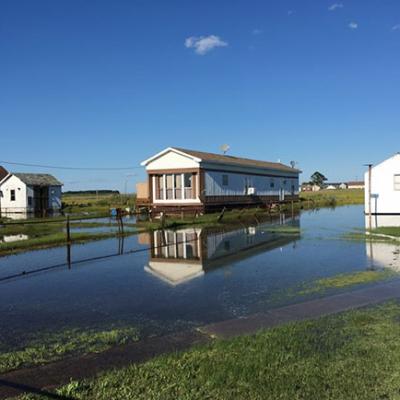Land Trusts May Be Solution to Climate-Driven Housing Shortage
Jonna Yarrington is an applied environmental anthropologist and postdoctoral researcher at the University of Virginia. She has been working at sites in the Chesapeake Bay since 2016, including a project in Norfolk with City Planning Commission Vice Chair Kim Sudderth beginning in 2021. The Virginian-Pilot published her op-ed on February 20, 2023.
Coastal residents are increasingly worried about sea-level rise. But displacement is not new. And there are strategies to resist it. Community land trusts emerged from the wreckage of gentrification and “redevelopment” in the later decades of the last century.
From the 1930s until fair housing rights were established in 1968, the federal government enabled white flight. Restrictive covenants, zoning and loan policies excluded the poor and people of color from growing suburbs. Federal administrators, developers, landlords, city governments, banks and realtors were all complicit and profited from the divestment of people and capital from cities.
In the 1970s, investors turned back to the deteriorating cities that whites had left. Seeing opportunity, they bought cheaply in low-income areas and funded redevelopment projects to attract more affluent, white residents. Desperate to reverse declining property values and grow the tax base, city governments were eager to appease.
But the rising tide did not lift all boats. As neighborhoods were redeveloped, residents were priced out, selling homes and facing ballooning rents, with nowhere affordable to relocate. With each project, the affordable housing supply dwindled further. This was how gentrification worked, and still does.
The financial profit created a problem for democratic representation. City councils could be distracted by an increasing tax base, as well as a changing urban landscape driven and designed by private industry headquartered elsewhere. While newer residents were welcomed, the concerns of existing residents were ignored, especially communities lacking organization and unable even to negotiate the terms of their removal.
It may be too late for places such as East Ghent, but the next waves of gentrification might be worse. The time is ticking for neighborhoods — as social and physical communities — to realize their potential and organize. While coastal and riverine areas subside, accessible digital data on vulnerable communities may have the unintended effect of highlighting areas for new redevelopment campaigns in a version of gentrification influenced by ideas about climate change.
It's time to consider community land trusts, which are designed to resist gentrification and build community wealth. They capitalize on the difference between land value and improvement (building) value, which are assessed annually for property taxes.
If land values are owned by a nonprofit community trust, then houses on that land can be exchanged at improvement value, making that housing permanently more affordable. Provisions in the land-lease agreement can incentivize passing that affordability on to tenants.
CLT participants are protected, in ways that individual homeowners and renters are not, from market fluctuations and physical losses. CLTs not only improve access to homeownership and equity, but they can help communities recover from natural disasters. As community organizations, CLTs can also host other educational, cooperative and neighborhood efforts.
The model has worked elsewhere for decades, from the Northeast to the Midwest to the Pacific Northwest, and even in Puerto Rico. Leasing land separately is a cornerstone of commercial property practices and a premise of homeowners’ associations. In this way, historically exclusionary powers can be repurposed to resist interacting future vulnerabilities of gentrification and even climate change.
What does it mean for residents to own shared stakes in the land on which they live? CLTs are an opportunity for neighborhoods and the city itself to reimagine concepts of ownership, stewardship and belonging.
If private interests dictate public policy and if the city continues to prioritize its short-term financial interests, then neighborhoods will continue to be displaced, affordable housing will always be out of reach, and the city will be stuck in a cycle of loss. Instead, by embracing CLTs as essential community organizations, Norfolk can choose real sustainability.
###


